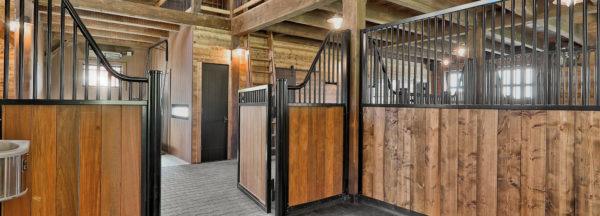Shedding Light on Health and Safety in Your Horse Barn

By Classic Equine Equipment
Imagine walking into a well-lit and welcoming barn. Your horses comfortably waiting in their stalls, eager for your attention. The aisle and stalls are evenly illuminated, making daily chores and barn activities easier and safer. Achieving this level of functionality requires thoughtful planning and the right lighting equipment. For the health and well-being of your horses and all who interact with them, consider the various ways you can ensure your barn is properly lit, safe, and inviting.
Easy Ways to Let the Natural Light In
Natural light is essential for health. While humans only require a half-hour to receive the amount of natural light to maintain health, horses need significantly more time to satisfy their bodies’ requirements. Unfiltered natural light provides vitamin D for your horses, which improves their health and supports their coat, joints, muscles, digestive system, and immune system. Sufficient exposure to light can also help regulate a horse’s appetite, digestion, sleep cycle, and reproductive cycle. Additionally, the UV rays in natural light can minimize bacterial growth. Sunlight and fresh air sweeping through a barn can contribute to disinfection, especially in areas like stalls.
Given these benefits and more, take advantage of natural light whenever possible. Having the right windows, shutters, and doors will provide you with optimal flexibility and control of the natural light in your horse barn. If you have a horse that requires limited exposure to sunlight due to a condition, such as uveitis, your strategy for managing the amount of natural light will be important.

- Windows allow natural light and fresh air to enter the barn. Polycarbonate window fill doesn’t shatter, making it a safer option than glass.
- Shutters on your barn’s exterior can be used to control the amount of direct natural light that enters through barn windows.
- Dutch doors provide an aesthetic appeal to your barn while prioritizing health and safety. Opening the top portion of the Dutch door lets in natural light and fresh air while allowing the horse to interact with the outside environment.
- Interior horse stall doors allow for maximum flow of air and light into the stall while preventing the horse from leaving its stall.
- Barn end doors and loft doors can be designed with polycarbonate window fills to allow natural light to enter while keeping people and horses safe and secure.
- Hinged and sliding horse stall fronts and partitions can be designed and built with grill or full-mesh fills, allowing light to stream in more freely.
Supplemental Fixtures for Proper Coverage
While it’s important to make the most of natural light, properly placed supplemental indoor light fixtures ensure your barn is evenly lit at all times of day. Horses are herd animals that are typically stabled in individual stalls. Barns with properly lit interiors allow horses to see their neighboring horses while in their stalls. A horse’s ability to see its herd members contributes to a more relaxed and stress-free environment.
At night, your barn can get surprisingly dark—especially in areas without proper lighting. If a vet had to come in an emergency, the last thing you’d want is for them to rely on flashlights. A simple solution? Set up two basic lighting options: one brighter setting for chores and vet visits, and one softer setting for general use. This way, you’ll have the right amount of light exactly when and where you need it—from the aisles to the stalls and wash bays.

- Ceiling-mounted lights work well inside the barn because they’re out of the way and less likely to be bumped or damaged. Install them over high-traffic areas like aisles and grooming stalls to improve visibility and help prevent accidents. Protect your bulbs with impact-resistant Lexan jelly jars or glass jelly jars with aluminum guards.
- Wall-mounted gooseneck fixtures work great both inside and outside your barn. Whether placed in aisleways or over doors, their curved design directs light exactly where you need it, providing soft, even lighting with fewer harsh shadows.
- T5 fluorescent lights are ideal for wash bays and grooming stalls, so you can easily see while caring for your horses. These lights are waterproof and can be pressure washed for easy cleaning. They use energy-saving bulbs that last up to 20,000 hours and feature rust-resistant fixtures. And since they start and restart instantly, you’re never left in the dark.

Just as a well-lit barn creates a safe space for horses and your daily tasks, the right combination of natural and supplemental lighting is essential for the well-being of horses and people alike. To ensure your barn offers the ideal light for health, safety, and comfort, reach out to a Design Consultant at Classic Equine Equipment. Our team is ready to help you protect what matters most.
